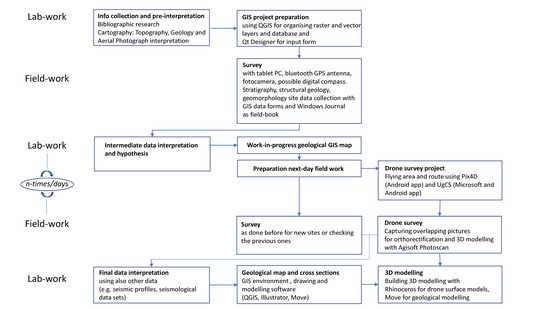Workflow of Digital Field Mapping and Drone-Aided Survey for the Identification and Characterization of Capable Faults: The Case of a Normal Fault System in the Monte Nerone Area (Northern Apennines, Italy)
Abstract
1. Introduction
1.1. Tectonic Lineaments
1.2. Geological Settings of the Study Area
1.3. Aims
2. Tools
2.1. Digital Field Mapping
2.2. UAV (Unnamed Aerial Vehicle) Survey
2.3. Three Dimensional Modeling
3. Methods and Workflow
3.1. Laboratory Work
- Geological maps from the same agency (Marche region geological map at the 1:10,000 scale) [53], which distribute raster (GeoTIFF) and vector (Shapefile format) formats at the same scale as the C.T.R.;
- Scanned and georeferenced raster maps of recent aerial photographs.
- Bed attitudes (points)—for dip data collected in the field;
- Fault data (points)—measurements on the fault surfaces, kinematic indicators, etc.;
- Outcrops (polygons)—for drawing geological units, facies, or guide layers;
- Annotation faults (lines)—for drawing tectonic lineaments;
- Field book (points)—for entering information collected in the “field book” using Windows Journal [44].
3.2. Field Work
3.3. Intermediate Laboratory Work
3.4. Continuing the Field Work
3.5. Final Laboratory Data Elaboration and Interpretation
4. Examples of the Laboratory Preparation, Field Mapping, and Final Interpretation Work
4.1. Initial Laboratory Work: Morphological Lineament Analysis
4.2. Field Work: Survey and Measurement Sites
- Sassorotto fault: The main fault cutting the crest of Monte Nerone and continuing SE (even if less evident); toward the NW, it reaches the Biscubio valley and continues toward Monte Vicino, affecting the Miocene terrigenous turbidites of the Marnoso Arenacea Formation.
- Col Lungo fault: A minor fault that shows important evidence of recent extensional activity from La Valle Agriturist, through the Col Lungo escarpment, to the road at the top of Monte Nerone and continuing with further morphological evidence to La Montagnola and beyond, toward the SE.
4.2.1. Site A1—Sassorotto (Field Mapping)
4.2.2. Site A5—Monte Forno (Field Mapping)
4.2.3. Site B3—Col Lungo (UAV Survey)
4.3. Intermediate Laboratory Work: Analyses of Fault Attitudes
5. GIS Elaboration of the Geological Map
6. Combining Other Data
6.1. Historical Seismicity
6.2. Instrumental Seismicity
7. Three Dimensional Modeling
8. Results and Discussion
8.1. Geological Results
- This study and the data collected led to a different interpretation than that reported in the literature (e.g., [20,71]). The results indeed highlighted the presence of a system of recent normal faults with respect to thrust and fold structures. The Sassorotto and Col Lungo faults showed irrefutable stratigraphic and structural evidence of extension. This system of shallow faults is very similar to those detected and mapped in the areas of the earthquakes in central Italy in 2009 and 2016 [5,72,73,74].
- Surface and deep reflection seismic data (CROP 03; [18,75]) crossing the mountain belt very close to the study area and the distribution of the epicenters [61] provide indications similar to those reported by various authors [3,27,28,29,76,77,78,79] for the southernmost areas shaken by recent earthquakes. In our case, the evidence of normal faulting on the surface could be related to deep stretching, with negative inversion of thrusts, as demonstrated in areas further south [80,81,82,83]. The interpretation that places the extensional regime now east of the Apennines watershed, toward the Adriatic, is also supported by evidence reported by several authors in neighboring areas [21,22,23,84,85].
8.2. Methodological Results
- The availability of inexpensive and now very popular tools allows everyone to work “digitally” in the field. Until a few years ago, tools such as tablet PCs were much more expensive [92], and their characteristics were somewhat limiting (performance, light readability, weight, etc.). For this study, normal tablet PCs (not ruggedized) were used, since the working conditions on the ground were not adverse (e.g., no rain or dust) and the covers used kept them safe from small falls. A normal tablet costs 4–5 times less than that of a ruggedized one and has a lower weight making it easier to carry in the field.
- The use of an external GPS receiver is a limitation, but only if the tablet and receiver are carried by different people. In this case, the Bluetooth connection could become disconnected and the software would thus not receive the necessary signal. To avoid this problem, a small pocket receiver weighing less than 100 g could be used to receive signals from different satellite constellations. Here, we used a cheap 51-channel receiver, which performs with high cartographic accuracy.
- The drones used were all common and affordable, capable of adequate flight times and extendable working times with additional batteries, and light weight to improve the transport possibilities. Drone operation is controlled by country laws and regulations that evolve fairly quickly in the attempt to adapt to technological innovations. Currently, in Italy, it is possible to use a drone with weight less than 300 g without particular restrictions. The drones we used were driven by students with a valid flight license and with the appropriate insurance, even if the areas flown over were mostly or completely uninhabited. Since drone flights allow the possibility to take very accurate photogrammetric images and extremely detailed DEM, such a digital survey method is an instrument of great potential.
- The integrated terrestrial and airborne digital survey systems enabled us to collect data from different observation points, a very important fact in the context of geological observations where it is important to switch from macro- to micro-scale and to different angles. The gathered data were organized on digital platforms as they were collected. This strategy provides some advantages such as the elimination of mistakes related to transcription and changes of scale [93]. An example is the case of the survey in the Monte Forno area, where the interpretative synthesis of both stratigraphy and tectonics was improved. The observations and mapping of the outcropping lithofacies enabled a first interpretation, even if the fault planes were not visible.
- The chance to work both in the field and in the laboratory with a single GIS software, such as QGIS desktop [35], without switching between different software and formats, is an advantage in terms of the time and the risk of introducing errors.
- To carry out a digital survey, appropriate tools are required that are suitable for field work. Here, new tools were created to be integrated with QGIS. The plug-ins described in the previous chapter were derived from the need for an easy method that is compatible with GIS, and that is also close to the traditional method of field work, i.e., pencils and paper maps. BeePen [36] and BeeJou, tools for quickly taking notes and georeferencing Windows Journal files, were conceived and created to take advantage of stylus and ink technology [94]. Moreover, the idea of a digital compass interacting directly and simply with the QGIS software led to the development (now at an advanced stage) of BeeDip [37], which is both an Android app for collecting structural data and a plug-in that allows the input and output exchange of data and maps between QGIS and the smartphone compass.
- The flexibility of the system in the organization of collected data allows changes/additions during the work. This becomes useful when new hypotheses are developed, when the area is not well-known, or when working in teams of geologists with different experiences and skills. In our case, this flexibility allowed to rearrange the project, using models that evolved during the work, contributing to the final synthesis. This feature, combined with the possibility of storing ideas, hypotheses, and validations in a temporal sequence, allows georeferencing of the analytical and deductive thinking that the geologist makes during field work and in the laboratory.
- The availability of well-organized digital data (tables, sheets, geolocation, etc.) allows a simpler, faster, and more correct import into cartographic and multidimensional modeling software. In addition to the classic geological maps, this method allows a more comprehensible overall synthesis, together with validation of the conclusions. In fact, in a three-dimensional model, for example, the shape and position of the fault tip lines must be defined as much as possible, while on geological maps they often end with uncertain dashed lines. Furthermore, it is possible to view geological/thematic themes on different cartographic bases as traditional topographic maps and aerial and/or satellite images, on digital cartographic (e.g., Google Maps and Open Street Maps) and modeling (e.g., Google Earth) platforms available online.
- The possibilities defined in the previous point, however, are the result of an interaction between different software, such as GIS, databases, modeling software, and web applications. The benefits of digital data exchange, therefore, are often in conflict with the different logic, tools, and procedures typical of any software. This can be a limitation in terms of both the time and efficiency lost among the various steps and processes. In some cases, the data collected and organized in GIS tables have to undergo transformations and reorganizations in order to become available in other software (e.g., Move), resulting in long working times and the possibility of introducing errors. Often, only familiarity and skill in the use of these software lead to workflow design and data organization from the beginning and contribute to the final synthesis.
Author Contributions
Funding
Acknowledgments
Conflicts of Interest
References
- Bemis, S.P.; Micklethwaite, S.; Turner, D.; James, M.R.; Akciz, S.; Thiele, S.T.; Bangash, H.A. Ground-based and UAV-Based photogrammetry: A multi-scale, high-resolution mapping tool for structural geology and paleoseismology. J. Struct. Geol. 2014, 69, 163–178. [Google Scholar] [CrossRef]
- Menichetti, M.; Piacentini, D.; De Donatis, M.; Roccheggiani, M.; Tamburini, A.; Tirincanti, E. Virtual outcrop and 3D structural analysis of Monte Vettore extensional active faults. In Proceedings of the 2016 Sessione Speciale Amatrice, GNGTS, Lecce, Italy, 22–24 November 2016. [Google Scholar]
- Pucci, S.; Martini, P.M.D.; Civico, R.; Villani, F.; Nappi, R.; Ricci, T.; Azzaro, R.; Brunori, C.A.; Caciagli, M.; Cinti, F.R.; et al. Coseismic ruptures of the 24 August 2016, Mw 6.0 Amatrice earthquake (central Italy). Geophys. Res. Lett. 2017, 44, 2138–2147. [Google Scholar] [CrossRef]
- Wilkinson, M.W.; McCaffrey, K.J.W.; Jones, R.R.; Roberts, G.P.; Holdsworth, R.E.; Gregory, L.C.; Walters, R.J.; Wedmore, L.; Goodall, H.; Iezzi, F. Near-field fault slip of the 2016 Vettore M w 6.6 earthquake (Central Italy) measured using low-cost GNSS. Sci. Rep. 2017, 7, 4612. [Google Scholar] [CrossRef] [PubMed]
- Civico, R.; Pucci, S.; Villani, F.; Pizzimenti, L.; Martini, P.M.D.; Nappi, R.; Open EMERGEO Working Group. Surface ruptures following the 30 October 2016 Mw 6.5 Norcia earthquake, central Italy. J. Maps 2018, 14, 151–160. [Google Scholar] [CrossRef]
- Gori, S.; Falcucci, E.; Galadini, F.; Zimmaro, P.; Pizzi, A.; Kayen, R.E.; Lingwall, B.N.; Moro, M.; Saroli, M.; Fubelli, G.; et al. Surface Faulting Caused by the 2016 Central Italy Seismic Sequence: Field Mapping and LiDAR/UAV Imaging. Earthq. Spectra 2018, 34, 1585–1610. [Google Scholar] [CrossRef]
- Nappi, R.; Alessio, G.; Gaudiosi, G.; Nave, R.; Marotta, E.; Siniscalchi, V.; Civico, R.; Pizzimenti, L.; Peluso, R.; Belviso, P.; et al. The 21 August 2017 Md 4.0 Casamicciola Earthquake: First Evidence of Coseismic Normal Surface Faulting at the Ischia Volcanic Island. Seismol. Res. Lett. 2018, 89, 1323–1334. [Google Scholar] [CrossRef]
- De Donatis, M.; Pappafico, G.F.; Romeo, R.W. A Field Data Acquisition Method and Tools for Hazard Evaluation of Earthquake-Induced Landslides with Open Source Mobile GIS. ISPRS Int. J. Geo-Inf. 2019, 8, 91. [Google Scholar] [CrossRef]
- Vignaroli, G.; Mancini, M.; Bucci, F.; Cardinali, M.; Cavinato, G.P.; Moscatelli, M.; Putignano, M.L.; Sirianni, P.; Santangelo, M.; Ardizzone, F.; et al. Geology of the central part of the Amatrice Basin (Central Apennines, Italy). J. Maps 2019, 15, 193–202. [Google Scholar] [CrossRef]
- Cirillo, D. Digital Field Mapping and Drone-Aided Survey for Structural Geological Data Collection and Seismic Hazard Assessment: Case of the 2016 Central Italy Earthquakes. Appl. Sci. 2020, 10, 5233. [Google Scholar] [CrossRef]
- Rovida, A.; Locati, M.; Camassi, R.; Lolli, B.; Gasperini, P. Catalogo Parametrico dei Terremoti Italiani (CPTI15), versione 2.0; Istituto Nazionale di Geofisica e Vulcanologia (INGV): Rome, Italy, 2019; p. 4760 earthquakes. [Google Scholar] [CrossRef]
- Baratta, M. Sul Terremoto di Cagli del 3 giugno 1781. Mem. Della Soc. Geogr. Ital. 1896, 5, 363–383. [Google Scholar]
- Monachesi, G. Revisione della Sismicità di Riferimento per i Comuni di Esanatoglia (MC), Cerreto d’Esi e Serra San Quirico (AN); Osservatorio Geofisico Sperimentale: Macerata, Italy, 1987; p. 240. [Google Scholar]
- Presciutti, G.; Presciutti, M.; Dromedari, G. Il Terremoto di Cagli del 3 Giugno 1781. Cronache dagli archivi; Youcanprint Self-Publishing Series; Youcanprint: Lecce, Italy, 2017; p. 84. ISBN 978-88-926-5298-9. [Google Scholar]
- ISIDe Working Group. Lista Terremoti Aggiornata in Tempo Reale INGV Osservatorio Nazionale Terremoti. Available online: http://iside.rm.ingv.it/ (accessed on 13 August 2020).
- Petricca, P.; Carminati, E.; Doglioni, C. The Decollement Depth of Active Thrust Faults in Italy: Implications on Potential Earthquake Magnitude. Tectonics 2019, 38, 3990–4009. [Google Scholar] [CrossRef]
- Lavecchia, G.; Minelli, G.; Pialli, G. The Umbria-Marche arcuate fold belt (Italy). Tectonophysics 1988, 146, 125–137. [Google Scholar] [CrossRef]
- Barchi, M.R.; Minelli, G.; Pialli, G. The CROP 03 profile; a synthesis of results on deep structures of the Northern Apennines. Mem. Soc. Geol. Ital. 1998, 52, 383–400. [Google Scholar]
- Malinverno, A.; Ryan, W.B.F. Extension in the Tyrrhenian Sea and shortening in the Apennines as result of arc migration driven by sinking of the lithosphere. Tectonics 1986, 5, 227–245. [Google Scholar] [CrossRef]
- Signorini, R. Un carattere strutturale frequente in Italia centrale. Boll. Della Soc. Geol. Ital. 1946, 65, 17–21. [Google Scholar]
- Barchi, M.; Menichetti, M.; Pialli, G.; Merangola, S.; Tosti, S.; Minelli, G. Struttura della ruga marchigiana esterna nel settore di M. S. Vicino-M. Canfaito. Boll. Soc. Geol. Ital. 1996, 115, 625–648. [Google Scholar]
- Savelli, D.; De Donatis, M.; Mazzoli, S.; Nesci, O.; Tramontana, M.; Veneri, F. Evidence for Quaternary faulting in the Metauro River basin (northern Marche Apennines). Boll. Soc. Geol. Ital. 2002, 1, 937–941. [Google Scholar]
- Borraccini, F.; De Donatis, M.; Di Bucci, D.; Mazzoli, S.; Megna, A.; Nesci, O.; Santini, S.; Savelli, D.; Tramontana, M. Quaternary Tectonics of the Northern Marche Region, and implications for active deformation in the outer Northern Apennines. Studi Geol. Camerti Nuova Serie 2004, 39–44. [Google Scholar] [CrossRef]
- Collettini, C.; De Paola, N.; Holdsworth, R.E.; Barchi, M.R. The development and behaviour of low-angle normal faults during Cenozoic asymmetric extension in the Northern Apennines, Italy. J. Struct. Geol. 2006, 28, 333–352. [Google Scholar] [CrossRef]
- Mirabella, F.; Brozzetti, F.; Lupattelli, A.; Barchi, M.R. Tectonic evolution of a low-angle extensional fault system from restored cross-sections in the Northern Apennines (Italy). Tectonics 2011, 30. [Google Scholar] [CrossRef]
- Chiaraluce, L.; Chiarabba, C.; Collettini, C.; Piccinini, D.; Cocco, M. Architecture and mechanics of an active low-angle normal fault: Alto Tiberina Fault, northern Apennines, Italy. J. Geophys. Res. Solid Earth 2007, 112. [Google Scholar] [CrossRef]
- Carannante, S.; Monachesi, G.; Cattaneo, M.; Amato, A.; Chiarabba, C. Deep structure and tectonics of the northern-central Apennines as seen by regional-scale tomography and 3-D located earthquakes. J. Geophys. Res. Solid Earth 2013, 118, 5391–5403. [Google Scholar] [CrossRef]
- Chiarabba, C.; Jovane, L.; DiStefano, R. A new view of Italian seismicity using 20 years of instrumental recordings. Tectonophysics 2005, 395, 251–268. [Google Scholar] [CrossRef]
- De Luca, G.; Cattaneo, M.; Monachesi, G.; Amato, A. Seismicity in Central and Northern Apennines integrating the Italian national and regional networks. Tectonophysics 2009, 476, 121–135. [Google Scholar] [CrossRef]
- Mantovani, E.; Viti, M.; Babbucci, D.; Tamburelli, C.; Vannucchi, A.; Falciani, F.; Cenni, N. Assetto Tettonico e Potenzialità Sismogenetica dell’Appennino Tosco-Umbro-Marchigiano; Università di Siena: Siena, Italy, 2014. [Google Scholar]
- Centamore, E.; Micarelli, A. Stratigrafia. In L’ambiente Fisico delle Marche Series; Regione Marche—Giunta Regionale, Assessorato Urbanistica e Ambiente; SELCA: Florence, Italy, 1991; p. 58. [Google Scholar]
- Alvarez, W. The Mountains of Saint Francis; W.W. Norton and Company: New York, NY, USA, 2009; ISBN 978-0-393-06185-7. [Google Scholar]
- Centamore, E.; Jacobacci, A.; Malferrari, N.; Martelli, G.; Pieruccini, U. Note Illustrative della Carta Geologica D’Italia Scala 1:50000—Foglio 290-Cagli 1972; Commissione Italiana di Stratigrafia: Florence, Italy, 1972. [Google Scholar]
- Ricci Lucchi, F. Turbidites and foreland basins: An Apenninic perspective. Mar. Pet. Geol. 2003, 20, 727–732. [Google Scholar] [CrossRef]
- QGIS Development Team QGIS Geographic Information System; Open Source Geospatial Foundation: 2019. Available online: https://qgis.org/it/site/ (accessed on 14 August 2020).
- Alberti, M. BeePen, Python Plugin for QGIS. 2019. Available online: https://github.com/mauroalberti/beePen (accessed on 14 August 2020).
- Cortellucci, D. Beedip, Python Plugin for QGIS. 2019. Available online: https://github.com/Dodoveloper/beedip (accessed on 14 August 2020).
- Alberti, M. DirectionaSlope, Python Plugin for QGIS. 2020. Available online: https://github.com/mauroalberti/directionalslope (accessed on 14 August 2020).
- Alberti, M. GIS analysis of geological surfaces orientations: The qgSurf plugin for QGIS. PeerJ 2019. [Google Scholar] [CrossRef]
- Alberti, M. qgSurf, Plugin for QGIS. 2020. Available online: https://github.com/mauroalberti/qgSurf (accessed on 14 August 2020).
- Regione Marche > Regione Utile > Paesaggio Territorio Urbanistica Genio Civile > Cartografia e informazioni territoriali > Repertorio > Carta Tecnica Numerica 1:10000. Available online: https://www.regione.marche.it/Regione-Utile/Paesaggio-Territorio-Urbanistica/Cartografia/Repertorio/Cartatecnicanumerica110000 (accessed on 13 August 2020).
- Carta Geologica Regionale 1:10000-Geotiff. Available online: https://www.regione.marche.it/Regione-Utile/Paesaggio-Territorio-Urbanistica-Genio-Civile/Cartografia-e-informazioni-territoriali/Repertorio/Carta-geologica-regionale-110000/Carta-geologica-regionale-110000-Geotiff (accessed on 13 August 2020).
- Qt Designer Software Version 4.8.6, Digia Plc and/or its Subsidiary(-ies) Programmers. Digia Plc. 2014. Available online: https://www.qt.io/design?utm_campaign=Navigation%202019&utm_source=Nav%202019 (accessed on 14 August 2020).
- Windows Journal Software for Windows 7; Microsoft Corporation. Available online: https://support.microsoft.com/en-us/help/3162655/windows-journal-application-for-windows (accessed on 14 August 2020).
- DJI Inspire 1. Available online: https://www.dji.com/it/inspire-1/info#specs (accessed on 14 August 2020).
- SPH Engineering Ground Station Software | UgCS PC Mission Planning. Available online: https://www.ugcs.com/ (accessed on 14 August 2020).
- Google Earth Pro Software, Version 7.3.3.7786 (64-bit); Google LLC Programmer. 2020. Available online: https://www.google.it/earth/download/gep/agree.html (accessed on 14 August 2020).
- Pix4D, S.A. Professional Photogrammetry and Drone Mapping Software. Available online: https://www.pix4d.com/ (accessed on 14 August 2020).
- Agisoft LLC Agisoft Metashape Software, Version 1.6.4. 2020. Available online: https://www.agisoft.com/ (accessed on 14 August 2020).
- Rhinoceros 3D Software, Version 6.0; Robert McNeel and Associates: Seattle, WA, USA, 2010.
- Midland Valley Exploration/Petex Ltd. MOVE Suite. Available online: http://www.petex.com/products/move-suite/ (accessed on 15 August 2020).
- OGC GeoTIFF Standard | OGC. Available online: https://www.ogc.org/standards/geotiff (accessed on 14 August 2020).
- Regione Marche > Regione Utile > Paesaggio Territorio Urbanistica Genio Civile > Cartografia e informazioni territoriali > Repertorio > Carta geologica regionale 1:10000. Available online: https://www.regione.marche.it/Regione-Utile/Paesaggio-Territorio-Urbanistica/Cartografia/Repertorio/Cartageologicaregionale10000 (accessed on 14 August 2020).
- Geoportale Nazionale—Ministero dell’Ambiente e della Tutela del Territorio e del Mare DTM 20 Metri. Available online: http://wms.pcn.minambiente.it/wcs/dtm_20m?service=wcs&request=getCapabilities (accessed on 14 August 2020).
- GeoPackage Encoding Standard | OGC. Available online: https://www.ogc.org/standards/geopackage (accessed on 14 August 2020).
- Ullman, S.; Brenner, S. The interpretation of structure from motion. Proc. R. Soc. Lond. Ser. B Biol. Sci. 1979, 203, 405–426. [Google Scholar] [CrossRef]
- Schönberger, J.L.; Frahm, J.M. Structure-from-motion revisited. In Proceedings of the 2016 IEEE Conference on Computer Vision and Pattern Recognition (CVPR), Las Vegas, NV, USA, 27–30 June 2016; pp. 4104–4113. [Google Scholar]
- Westoby, M.J.; Brasington, J.; Glasser, N.F.; Hambrey, M.J.; Reynolds, J.M. ‘Structure-from-Motion’ photogrammetry: A low-cost, effective tool for geoscience applications. Geomorphology 2012, 179, 300–314. [Google Scholar] [CrossRef]
- Johnson, K.; Nissen, E.; Saripalli, S.; Arrowsmith, J.R.; McGarey, P.; Scharer, K.; Williams, P.; Blisniuk, K. Rapid mapping of ultrafine fault zone topography with structure from motion. Geosphere 2014, 10, 969–986. [Google Scholar] [CrossRef]
- ViDEPI Project. Available online: https://www.videpi.com/videpi/videpi.asp (accessed on 14 August 2020).
- ISIDe Working Group. Italian Seismological Instrumental and Parametric Database (ISIDe); Istituto Nazionale di Geofisica e Vulcanologia (INGV): Rome, Italy, 2007. [Google Scholar]
- Centamore, E.; Chiocchini, U.; Micarelli, A. Analisi dell’evoluzione tettonico-sedimentaria dei «Bacini Minori» torbiditici del Miocene medio-superiore nell’Appennino Umbro-Marchigiano e Laziale-Abruzzese 3) Le Arenarie di M. Vicino, un modello di conoide sottomarina affogata (Marche Settentrionali). Studi Geol. Camerti 1977, 3, 7–56. [Google Scholar]
- Rovida, A.; Locati, M.; Antonucci, A.; Camassi, R. Italian Archive of Historical Earthquake Data (ASMI); Istituto Nazionale di Geofisica e Vulcanologia (INGV): Rome, Italy, 2017. [Google Scholar] [CrossRef]
- Rovida, A.; Locati, M.; Camassi, R.; Lolli, B.; Gasperini, P. Italian Parametric Earthquake Catalogue (CPTI15), Version 2.0; Istituto Nazionale di Geofisica e Vulcanologia (INGV): Rome, Italy, 2019. [Google Scholar]
- Rovida, A.; Locati, M.; Camassi, R.; Lolli, B.; Gasperini, P. The Italian earthquake catalogue CPTI15. Bull. Earthq. Eng. 2020, 18, 2953–2984. [Google Scholar] [CrossRef]
- Camassi, R.; Castelli, V.; Molin, D.; Bernardini, F.; Caracciolo, C.H.; Ercolani, E.; Postpischl, L. Materiali per un catalogo dei terremoti italiani: Eventi sconosciuti, rivalutati o riscoperti. Quad. Di Geofis. 2011, 96, 1–53. [Google Scholar]
- Borraccini, F.; Donatis, M.D.; Bucci, D.D.; Mazzoli, S. 3D Model of the active extensional system of the high Agri River Valley. J. Virtual Explor. 2002, 6, 1–6. [Google Scholar] [CrossRef]
- D’Ambrogi, C.; Pantaloni, M.; Borraccini, F.; De Donatis, M. A 3D Geological model of the Fossombrone area (Northern Apennines). In Mapping Geology in Italy; Pasquarè, G., Venturini, C., Eds.; S.E.L.C.A.: Florence, Italy, 2004; pp. 193–198. ISBN 88-448-0189-2. [Google Scholar]
- De Donatis, M.; Borraccini, F.; Susini, S. Sheet 280—Fossombrone 3D: A study project for a new geological map of Italy in three dimensions. Comput. Geosci. 2009, 35, 19–32. [Google Scholar] [CrossRef]
- De Donatis, M.; Susini, S.; Mirabella, F.; Lupattelli, A.; Barchi, M. 4D modelling of the Alto Tiberina Fault system (Northern Apennines, Italy). In Proceedings of the Geophysical Research Abstracts, Vienna, Austria, 27 April–2 May 2014; Volume 16. [Google Scholar]
- Corsi, M.; De Feyter, A.J. The thrust front of the Umbro-Romagnan parautochthon SW of Palcano (Umbro-Marchean Apennines, Italy). Boll. Della Soc. Geol. Ital. 1991, 110, 693–708. [Google Scholar]
- Boncio, P.; Pizzi, A.; Brozzetti, F.; Pomposo, G.; Lavecchia, G.; Naccio, D.D.; Ferrarini, F. Coseismic ground deformation of the 6 April 2009 L’Aquila earthquake (central Italy, Mw6.3). Geophys. Res. Lett. 2010, 37. [Google Scholar] [CrossRef]
- Emergeo, W.G.; Pucci, S.; Martini, P.M.D.; Civico, R.; Nappi, R.; Ricci, T.; Villani, F.; Brunori, C.A.; Caciagli, M.; Sapia, V.; et al. Coseismic effects of the 2016 Amatrice seismic sequence: First geological results. Ann. Geophys. 2016, 59. [Google Scholar] [CrossRef]
- Iezzi, F.; Roberts, G.; Walker, J.F.; Papanikolaou, I. Occurrence of partial and total coseismic ruptures of segmented normal fault systems: Insights from the Central Apennines, Italy. J. Struct. Geol. 2019, 126, 83–99. [Google Scholar] [CrossRef]
- Barchi, M.; Minelli, G.; Magnani, B.; Mazzotti, A. Line CROP 03: Northern Apennines. Mem. Descr. Della Carta Geol. D’Italia 2003, 62, 127–136. [Google Scholar]
- Boncio, P.; Ponziani, F.; Brozzetti, F.; Barchi, M.; Lavecchia, G.; Pialli, G. Seismicity and extensional tectonics in the Northern Umbria-Marche Apennines. Mem. Soc. Geol. Ital. 1998, 52, 539–555. [Google Scholar]
- Chiarabba, C.; De Gori, P.; Mele, F.M. Recent seismicity of Italy: Active tectonics of the central Mediterranean region and seismicity rate changes after the Mw 6.3 L’Aquila earthquake. Tectonophysics 2015, 638, 82–93. [Google Scholar] [CrossRef]
- Bignami, C.; Valerio, E.; Carminati, E.; Doglioni, C.; Tizzani, P.; Lanari, R. Volume unbalance on the 2016 Amatrice—Norcia (Central Italy) seismic sequence and insights on normal fault earthquake mechanism. Sci. Rep. 2019, 9, 4250. [Google Scholar] [CrossRef] [PubMed]
- Improta, L.; Latorre, D.; Margheriti, L.; Nardi, A.; Marchetti, A.; Lombardi, A.M.; Castello, B.; Villani, F.; Ciaccio, M.G.; Mele, F.M.; et al. Multi-segment rupture of the 2016 Amatrice-Visso-Norcia seismic sequence (central Italy) constrained by the first high-quality catalog of Early Aftershocks. Sci. Rep. 2019, 9, 6921. [Google Scholar] [CrossRef] [PubMed]
- Chimera, G.; Aoudia, A.; Saraò, A.; Panza, G.F. Active tectonics in Central Italy: Constraints from surface wave tomography and source moment tensor inversion. Phys. Earth Planet. Inter. 2003, 138, 241–262. [Google Scholar] [CrossRef]
- Scognamiglio, L.; Tinti, E.; Casarotti, E.; Pucci, S.; Villani, F.; Cocco, M.; Magnoni, F.; Michelini, A.; Dreger, D. Complex Fault Geometry and Rupture Dynamics of the MW 6.5, 30 October 2016, Central Italy Earthquake. J. Geophys. Res. Solid Earth 2018, 123, 2943–2964. [Google Scholar] [CrossRef]
- Buttinelli, M.; Pezzo, G.; Valoroso, L.; De Gori, P.; Chiarabba, C. Tectonics Inversions, Fault Segmentation, and Triggering Mechanisms in the Central Apennines Normal Fault System: Insights from High-Resolution Velocity Models. Tectonics 2018, 37, 4135–4149. [Google Scholar] [CrossRef]
- Ercoli, M.; Forte, E.; Porreca, M.; Carbonell, R.; Pauselli, C.; Minelli, G.; Barchi, M.R. Using seismic attributes in seismotectonic research: An application to the Norcia Mw = 6.5 earthquake (30 October 2016) in central Italy. Solid Earth 2020, 11, 329–348. [Google Scholar] [CrossRef]
- Di Bucci, D.; Mazzoli, S.; Nesci, O.; Savelli, D.; Tramontana, M.; De Donatis, M.; Borraccini, F. Active deformation in the frontal part of the Northern Apennines: Insights from the lower Metauro River basin area (northern Marche, Italy) and adjacent Adriatic off-shore. J. Geodyn. 2003, 36, 213–238. [Google Scholar] [CrossRef]
- Borraccini, F.; De Donatis, M.; Mazzoli, S.; Savelli, D. 3D Structure of The Northern Marche Region, And Implications For The Active Tectonics Of The Outer Northern Apennines (Italy). J. Virtual Explor. 2005, 18. [Google Scholar] [CrossRef]
- Smacchia, B. Individuazione e Origine Delle Anomalie dei Profili Longitudinali dei Corsi D’acqua del Bacino del Candigliano, Marche Settentrionali; Tesi di Laurea Magistrale, Università degli Studi di Urbino: Urbino, Italy, 2017. [Google Scholar]
- Piacentini, D.; Troiani, F.; Servizi, T.; Nesci, O.; Veneri, F. SLiX: A GIS Toolbox to Support Along-Stream Knickzones Detection through the Computation and Mapping of the Stream Length-Gradient (SL) Index. ISPRS Int. J. Geo-Inf. 2020, 9, 69. [Google Scholar] [CrossRef]
- Alexander, D. Relief inversion by denudation of the Monte Nerone anticline, central Italy. Geomorphology 1988, 1, 87–109. [Google Scholar] [CrossRef]
- ITHACA—Faglie Capaci WebPage. Available online: http://sgi2.isprambiente.it/ithacaweb/FagliaCapace.aspx#1 (accessed on 17 August 2020).
- IAEA SSG-9 Seismic Hazards in Site Evaluation for Nuclear Installations; Specific Safety Guides; International Atomic Energy Agency: Vienna, Austria, 2010; ISBN 978-92-0-102910-2.
- IAEA TECDOC 1767 The Contribution of Palaeoseismology to Seismic Hazard Assessment in Site Evaluation for Nuclear Installations; TECDOC Series; International Atomic Energy Agency: Vienna, Austria, 2015; ISBN 978-92-0-105415-9.
- Clegg, P.; Bruciatelli, L.; Domingos, F.; Jones, R.R.; De Donatis, M.; Wilson, R.W. Digital geological mapping with tablet PC and PDA: A comparison. Comput. Geosci. 2006, 32, 1682–1698. [Google Scholar] [CrossRef]
- Campbell, E.; Duncan, I.; Hibbitts, H. Analysis of errors occurring in the transfer of geologic point data from field maps to digital data sets. In Proceedings of the Digital Mapping Techniques ‘05—Workshop Proceedings, Baton Rouge, LA, USA, 24–27 April 2005; pp. 61–65. [Google Scholar]
- De Donatis, D.D.M.; Bruciatelli, B.L. MAP IT: The GIS software for field mapping with tablet pc. Comput. Geosci. 2006, 32, 673–680. [Google Scholar] [CrossRef]
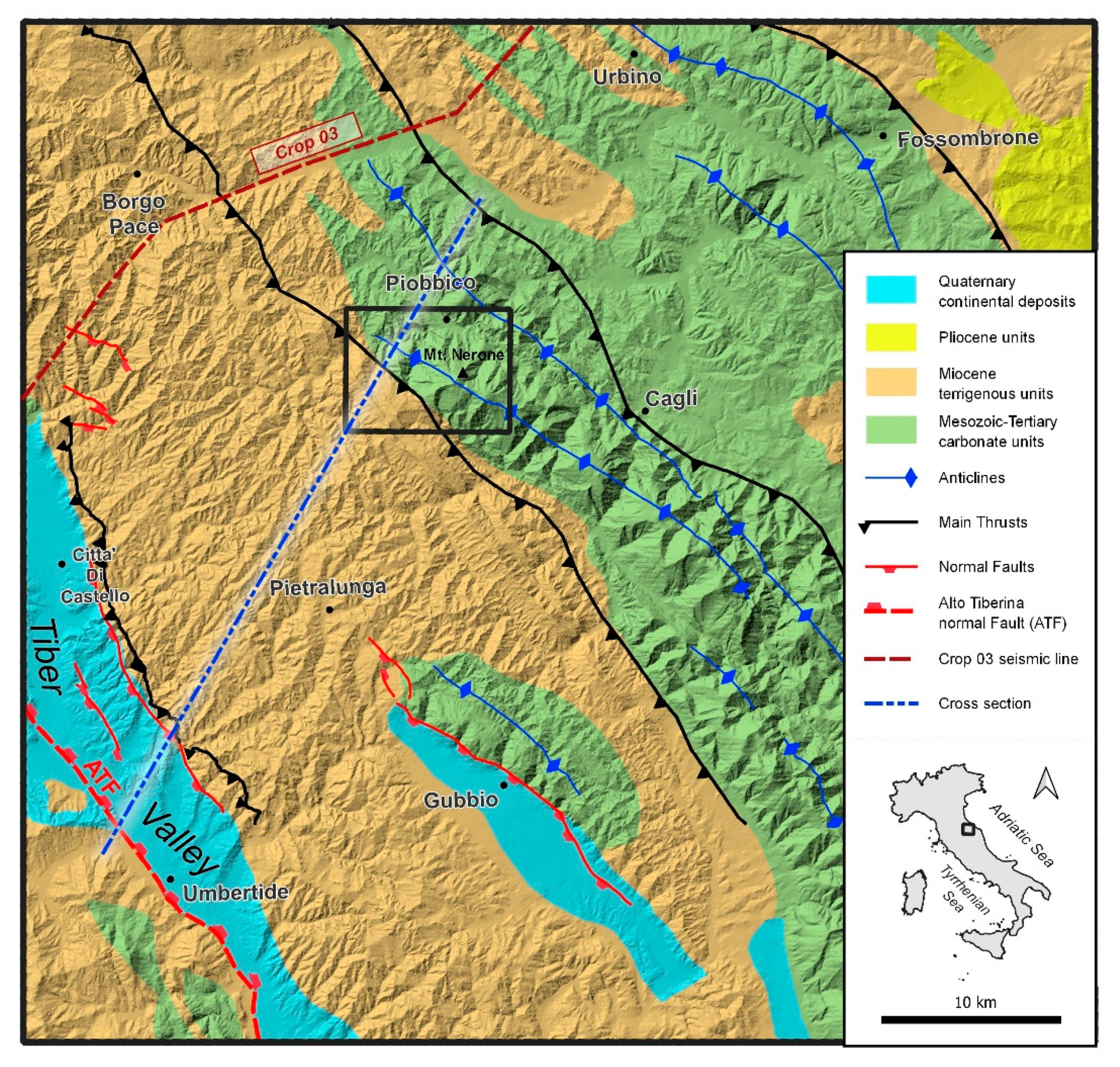
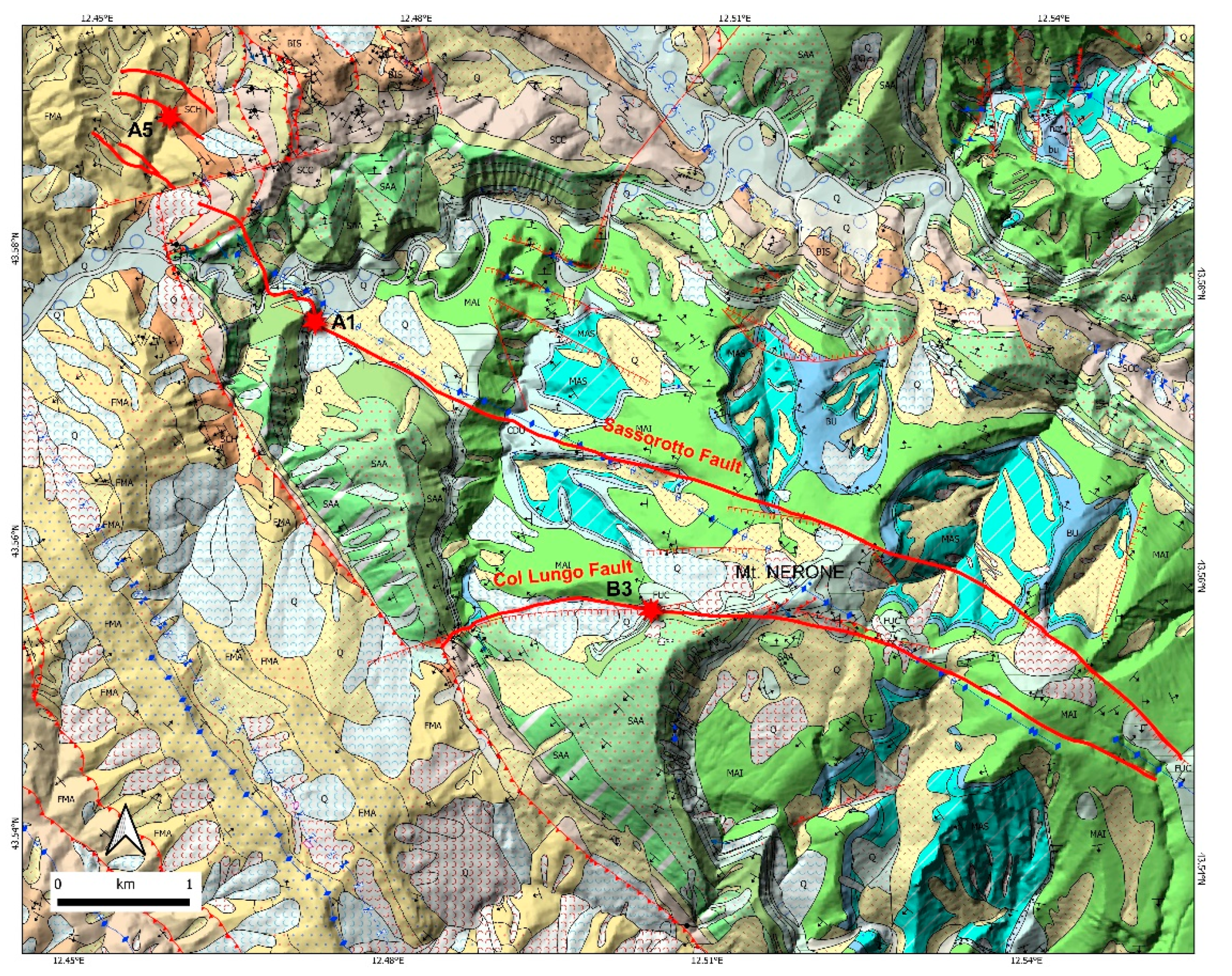
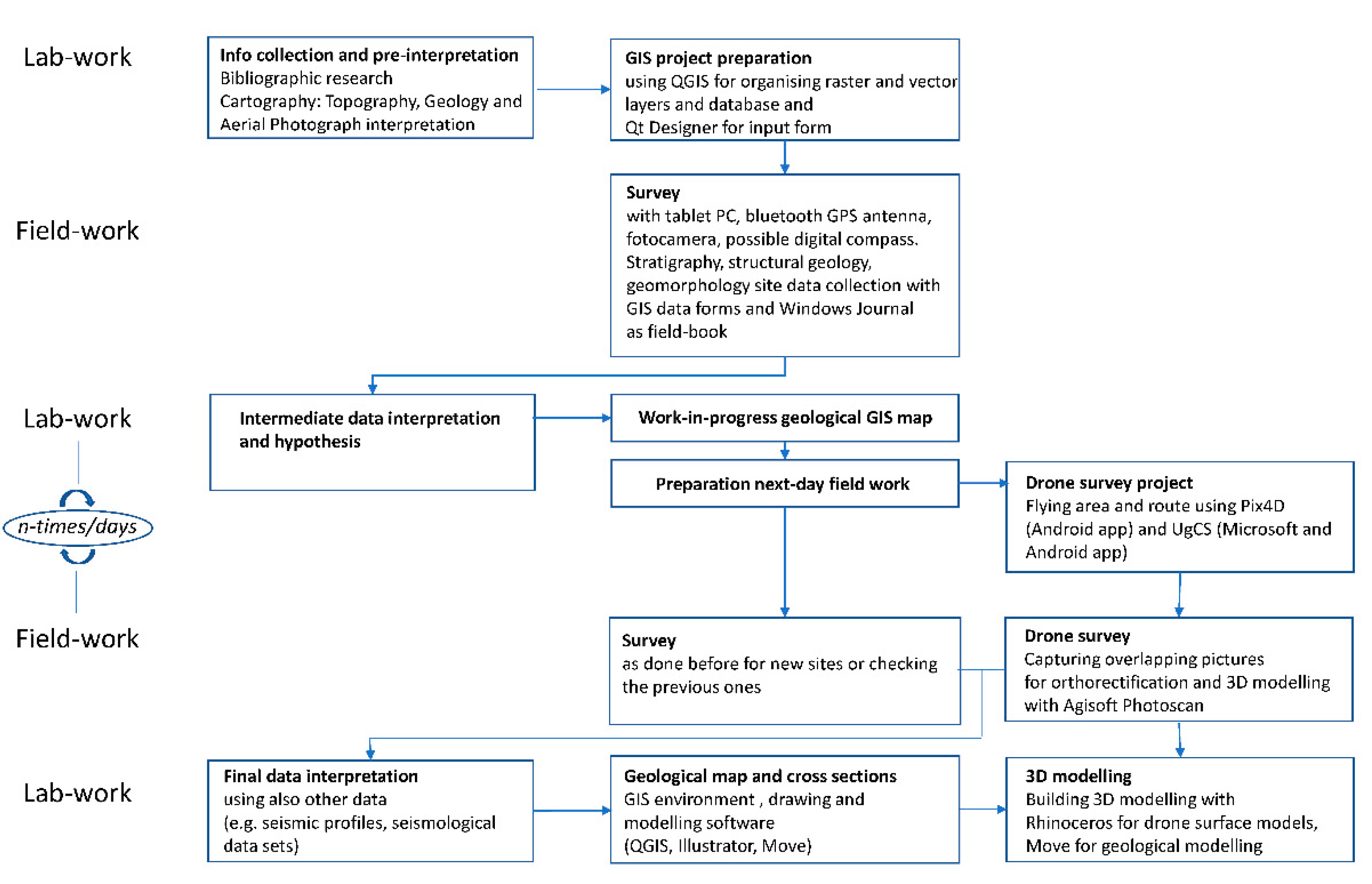
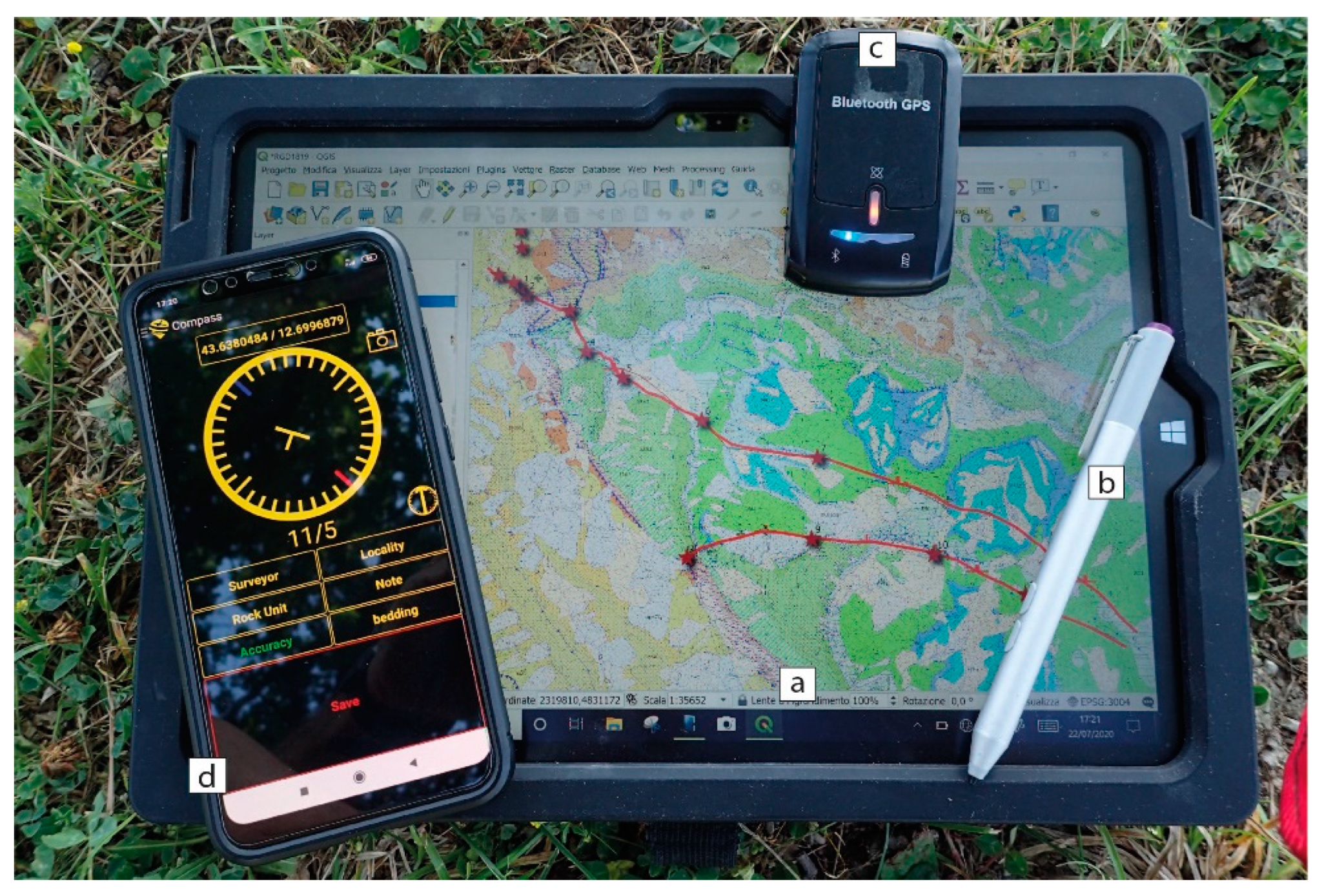
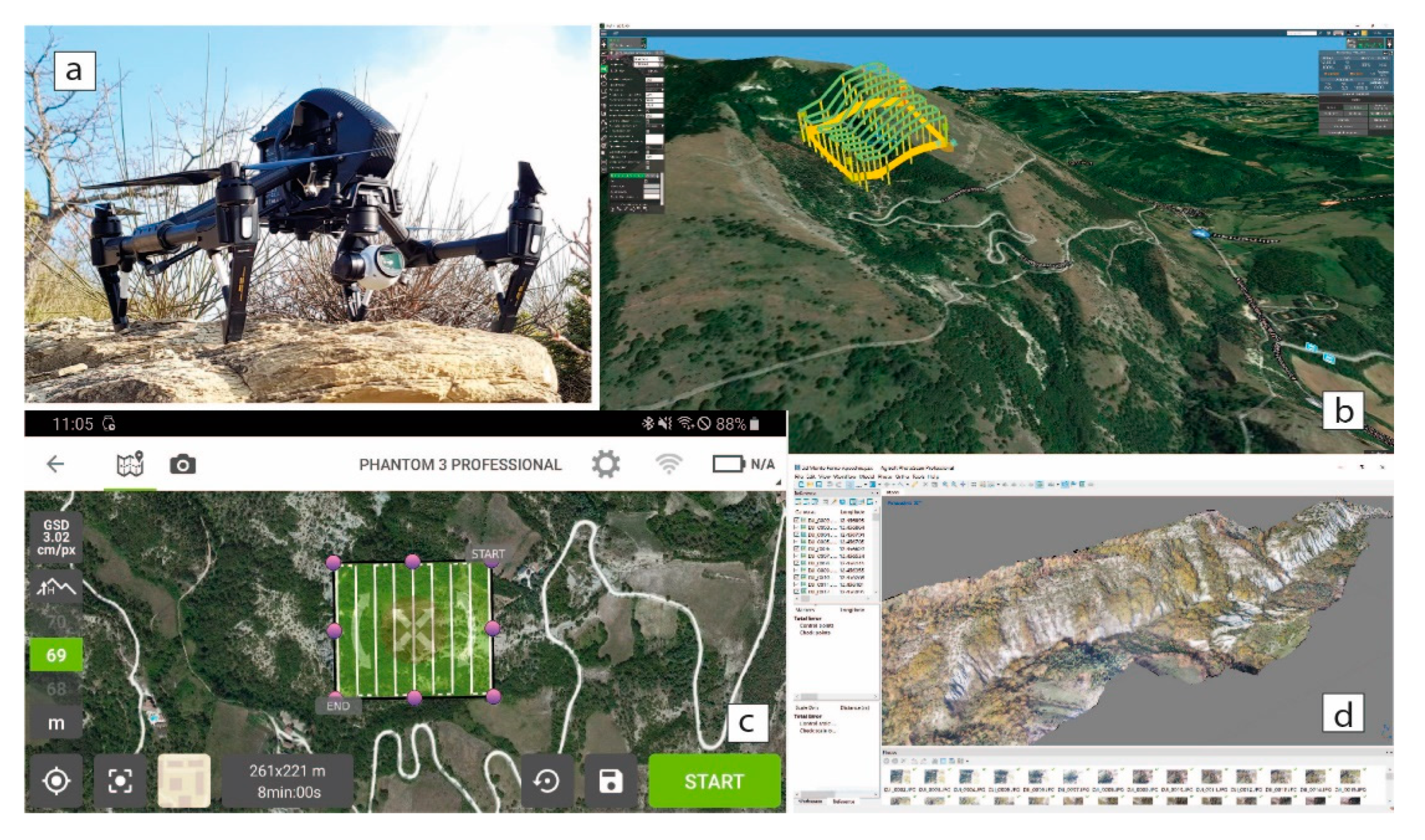


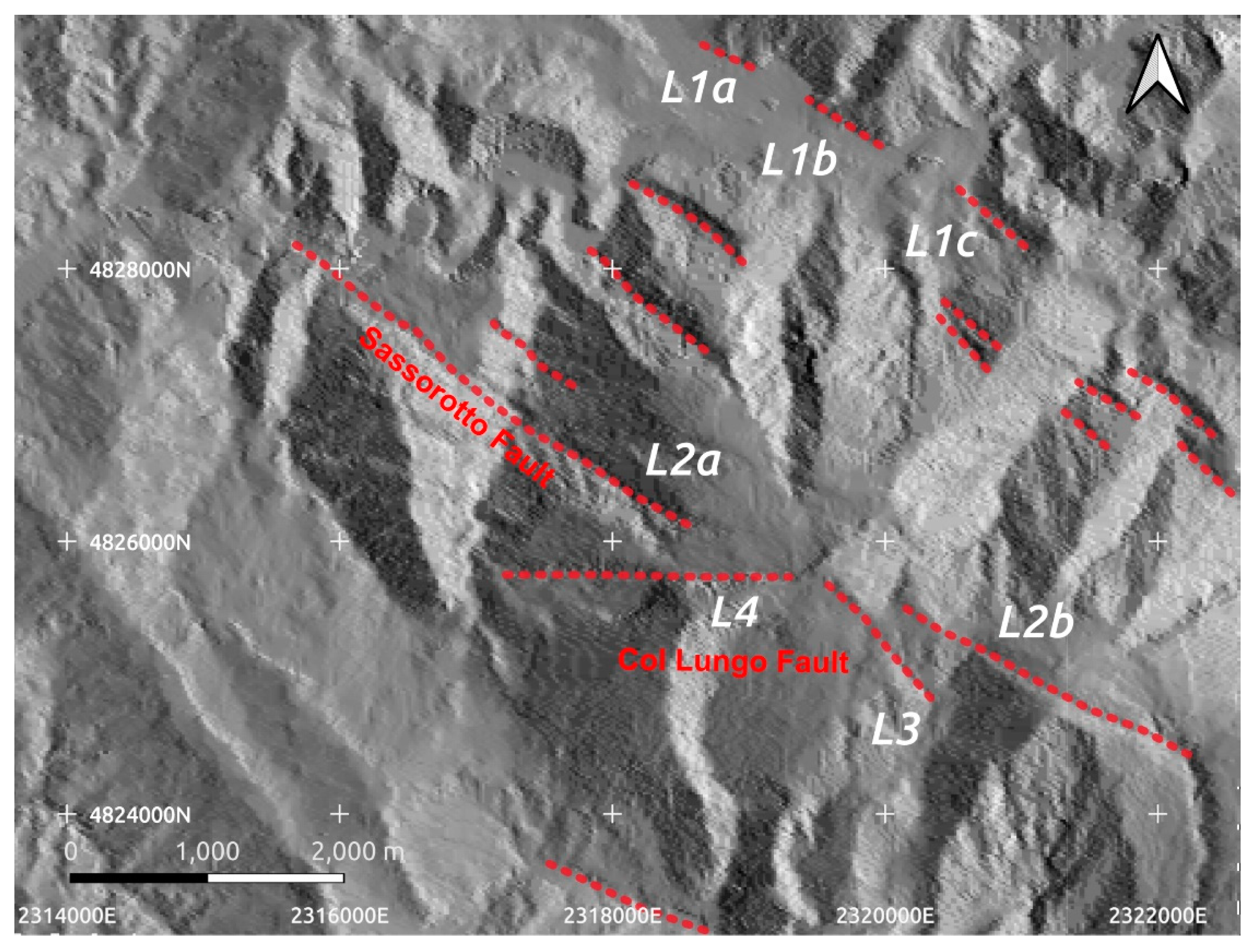
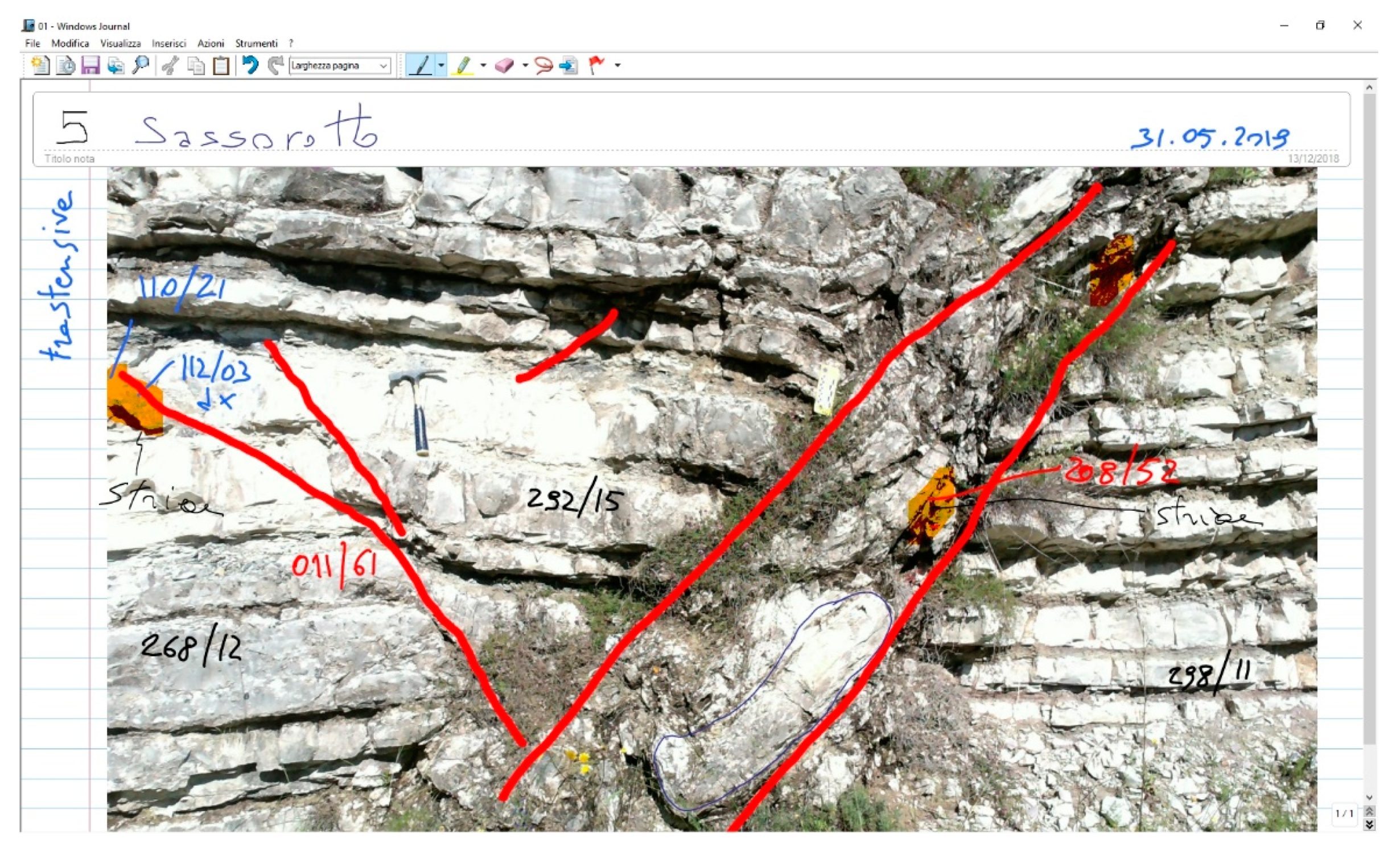
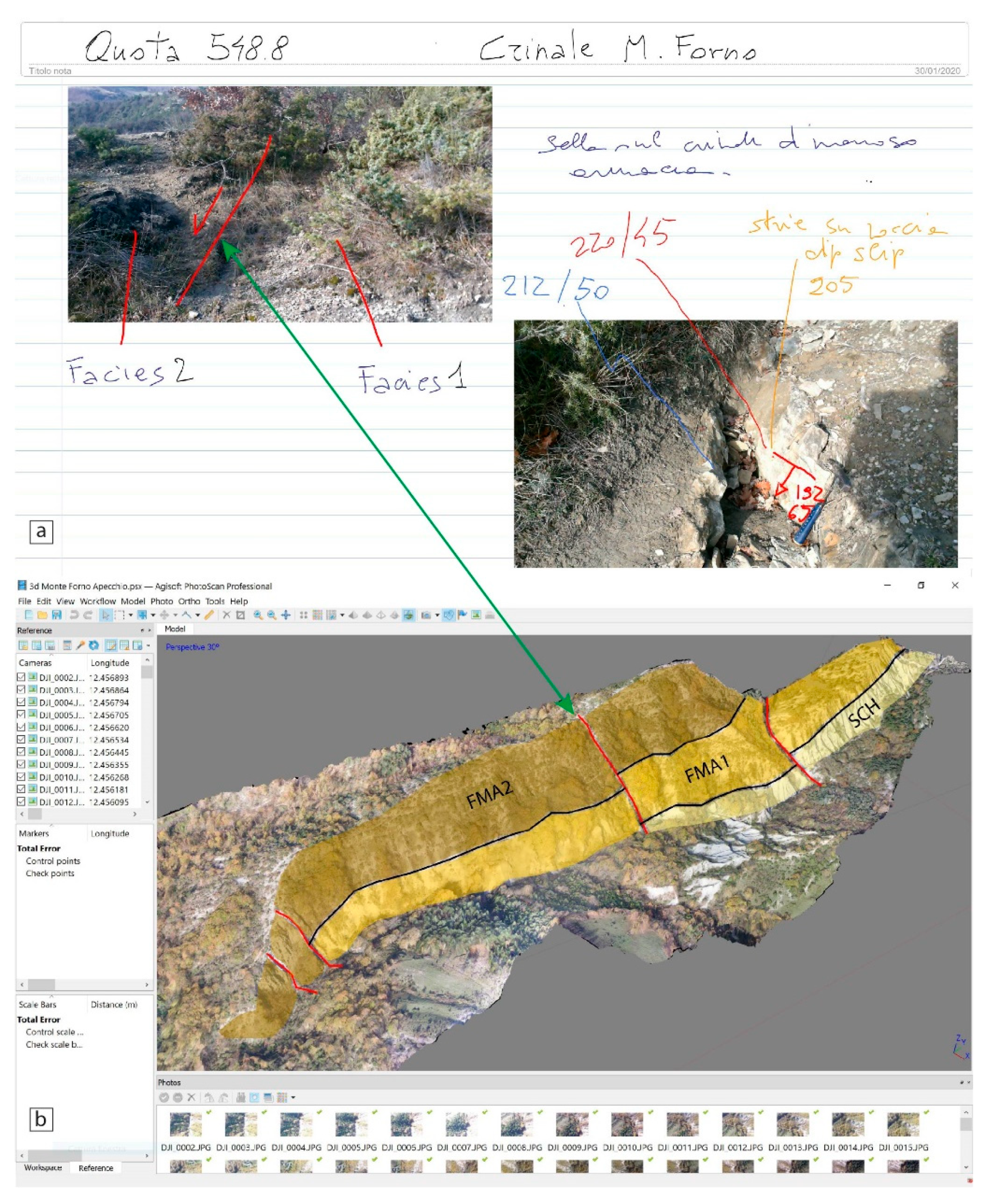
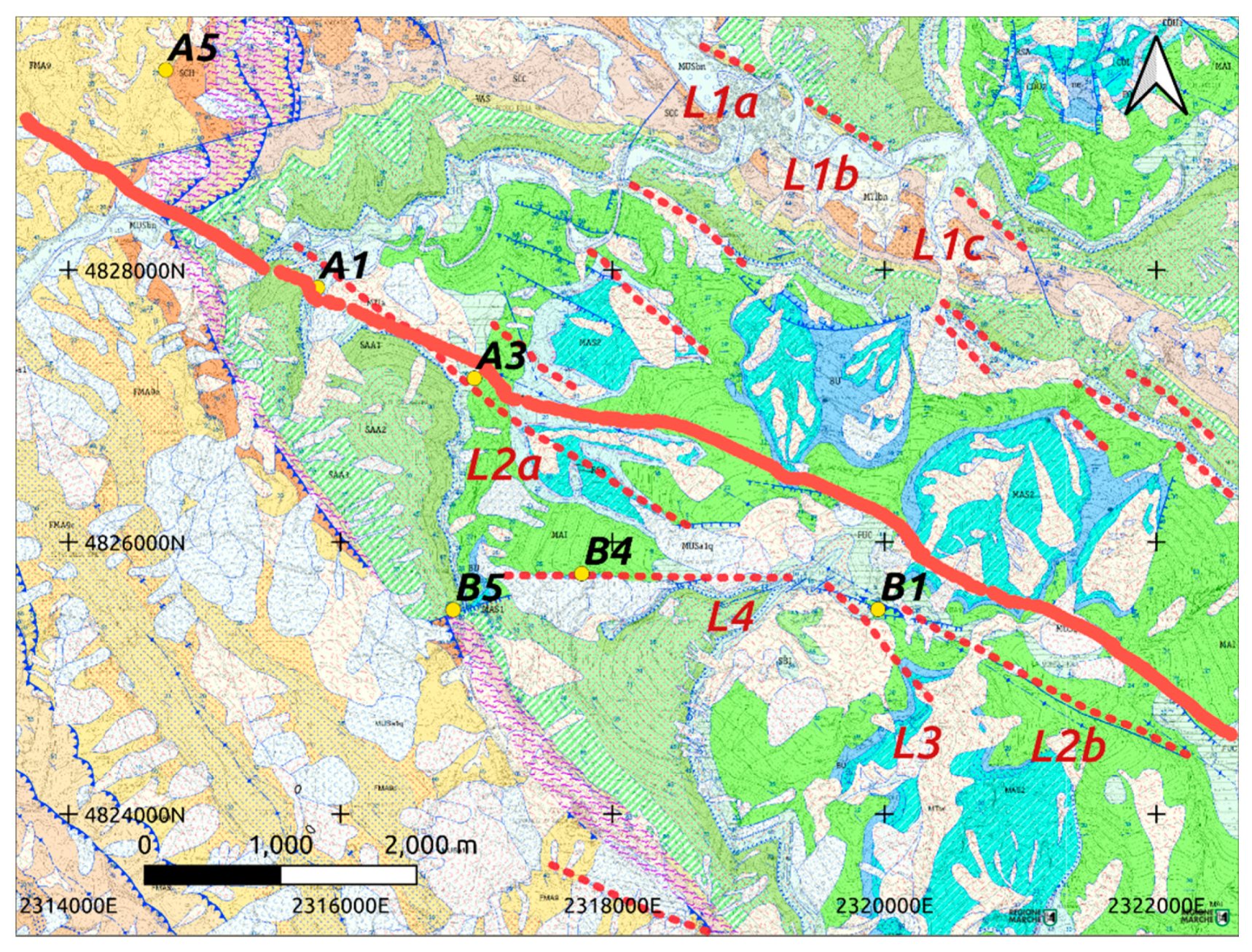
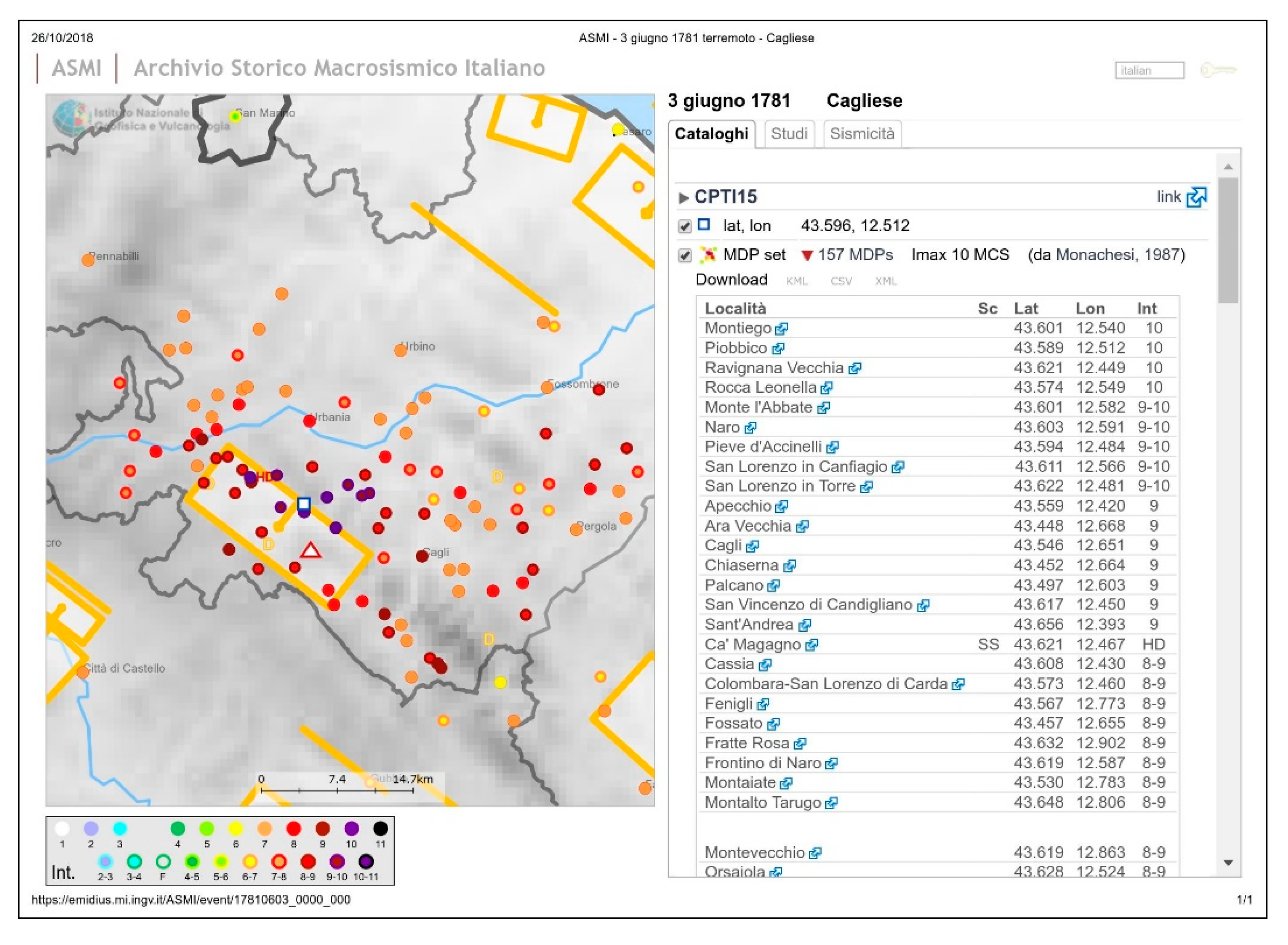
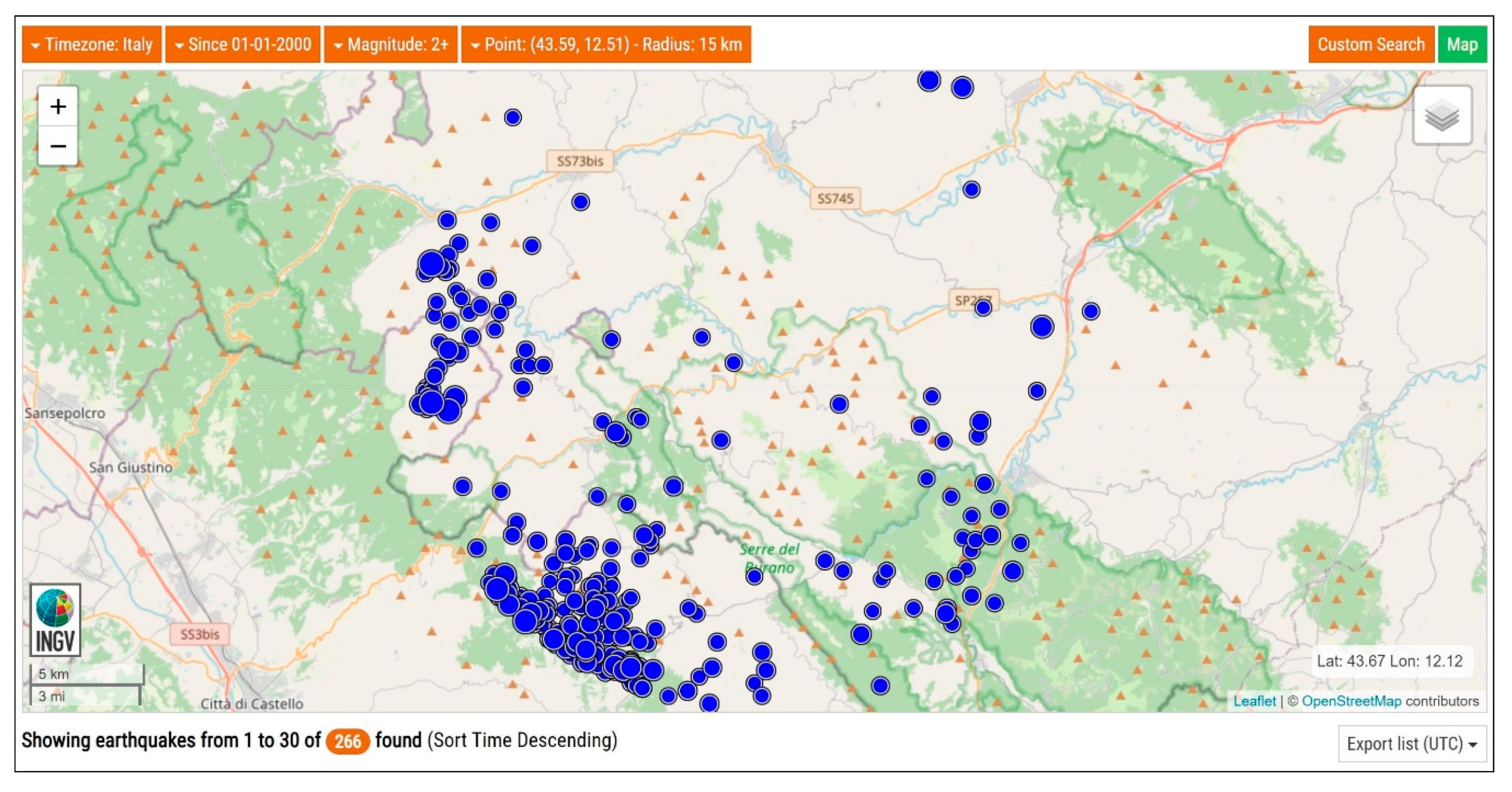
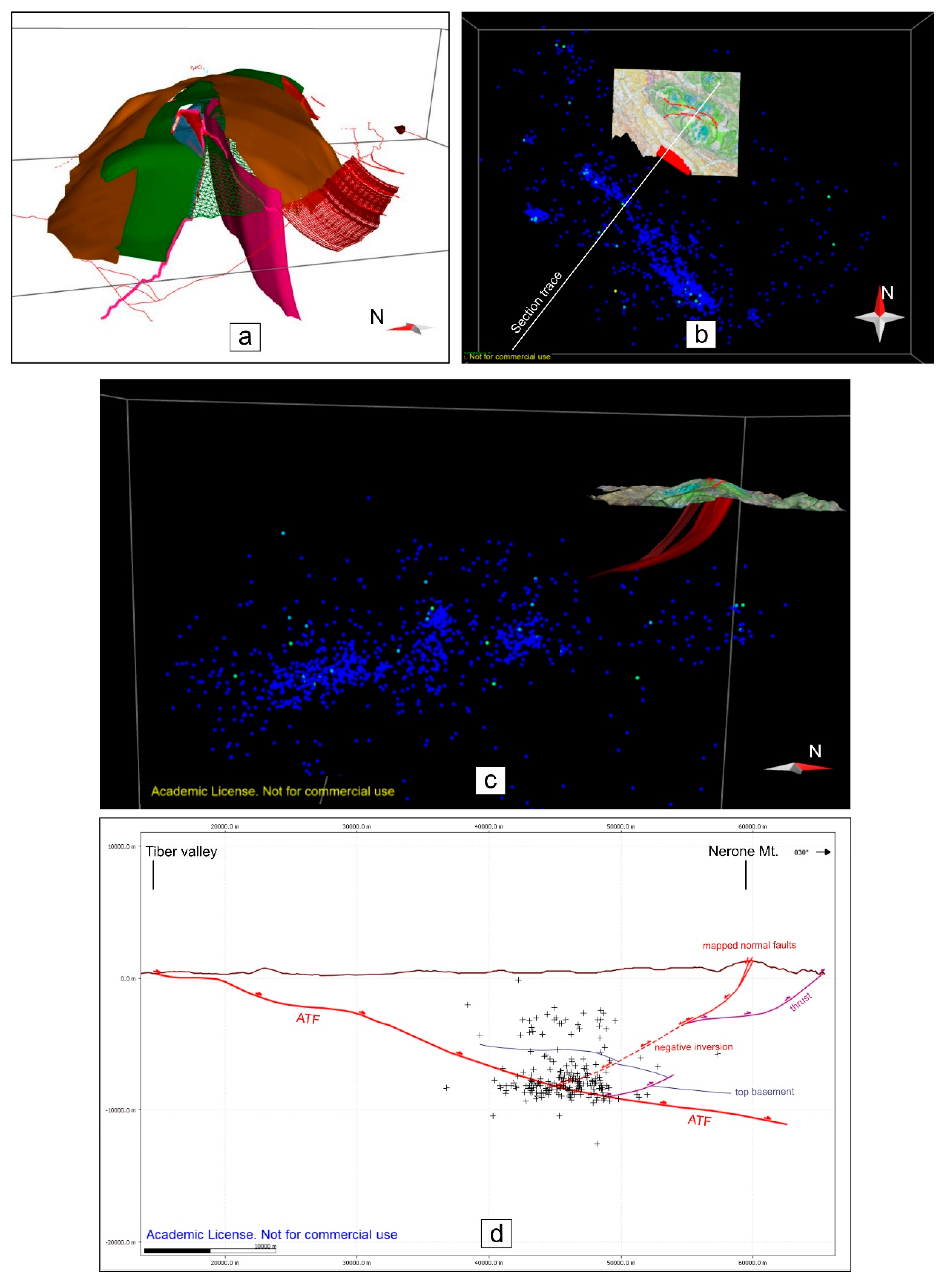
Publisher’s Note: MDPI stays neutral with regard to jurisdictional claims in published maps and institutional affiliations. |
© 2020 by the authors. Licensee MDPI, Basel, Switzerland. This article is an open access article distributed under the terms and conditions of the Creative Commons Attribution (CC BY) license (http://creativecommons.org/licenses/by/4.0/).
Share and Cite
De Donatis, M.; Alberti, M.; Cipicchia, M.; Guerrero, N.M.; Pappafico, G.F.; Susini, S. Workflow of Digital Field Mapping and Drone-Aided Survey for the Identification and Characterization of Capable Faults: The Case of a Normal Fault System in the Monte Nerone Area (Northern Apennines, Italy). ISPRS Int. J. Geo-Inf. 2020, 9, 616. https://doi.org/10.3390/ijgi9110616
De Donatis M, Alberti M, Cipicchia M, Guerrero NM, Pappafico GF, Susini S. Workflow of Digital Field Mapping and Drone-Aided Survey for the Identification and Characterization of Capable Faults: The Case of a Normal Fault System in the Monte Nerone Area (Northern Apennines, Italy). ISPRS International Journal of Geo-Information. 2020; 9(11):616. https://doi.org/10.3390/ijgi9110616
Chicago/Turabian StyleDe Donatis, Mauro, Mauro Alberti, Mattia Cipicchia, Nelson Muñoz Guerrero, Giulio F. Pappafico, and Sara Susini. 2020. "Workflow of Digital Field Mapping and Drone-Aided Survey for the Identification and Characterization of Capable Faults: The Case of a Normal Fault System in the Monte Nerone Area (Northern Apennines, Italy)" ISPRS International Journal of Geo-Information 9, no. 11: 616. https://doi.org/10.3390/ijgi9110616
APA StyleDe Donatis, M., Alberti, M., Cipicchia, M., Guerrero, N. M., Pappafico, G. F., & Susini, S. (2020). Workflow of Digital Field Mapping and Drone-Aided Survey for the Identification and Characterization of Capable Faults: The Case of a Normal Fault System in the Monte Nerone Area (Northern Apennines, Italy). ISPRS International Journal of Geo-Information, 9(11), 616. https://doi.org/10.3390/ijgi9110616





